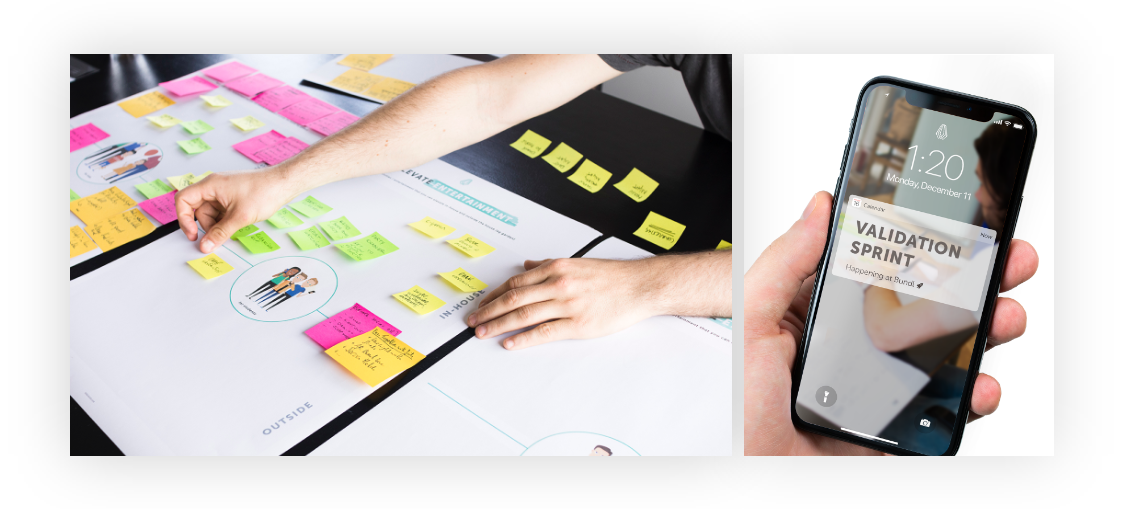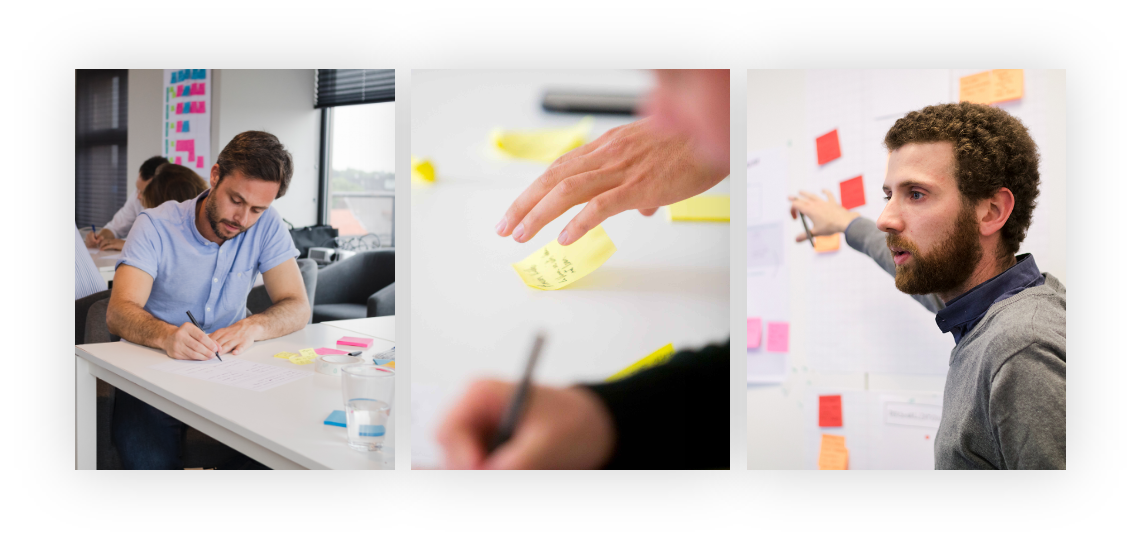Key takeaways
Design Sprints have become a common practice in disruptive companies like Airbnb, Amazon, Facebook, and Uber who all use them to help unlock creativity, innovate, and build prototypes in a short period of time.
But what happens after that first Design Sprint is over? How can you ensure that your efforts don’t end up getting delayed or stuck due to internal meetings, endless discussions, or a general lack of focus among your colleagues?
If you’re currently facing a similar challenge, you’re in luck!
We’ve created a “sequel” to the Design Sprint saga: Meet the Validation Sprint!
What is a Validation Sprint ?
A Validation Sprint is similar to a Design Sprint in terms of structure and technique, but it’s quite different in terms of its end goal.
Let’s take a closer look at some of the differences.
The goal of a Design Sprint
The goal of a Design Sprint is to help teams define clear goals, create roadmaps and validate assumptions through ideation, design, testing, and prototyping.
Here’s an example 💡
Let’s say you’re the Innovation Manager of a commercial bank and you’ve noticed a sharp spike in freelance clients. In response to this trend, you’d like to launch a new service focused on serving the needs of this growing section in your market.
In this case, a Design Sprint is a perfect way for you to get the project off the ground.
The result? “MagicBank”, an automated service that helps freelancers generate invoices, track their expenses and manage their taxes.
Essentially, you’ve created a roadmap to help transform your idea into a reality, which is the main goal of a Design Sprint.
The goal of a Validation Sprint
On the other hand, the goal of a Validation Sprint is to build a series of experiments that will confirm or reject the assumptions made about a product or service.
Here’s an example 💡
The idea for MagicBank is quite promising, but you need solid data before you can secure the investment you need to get your project up and running.
In this case, a Validation Sprint is the most efficient way to get the proof of concept you’re looking for because it will enable you to confirm the findings from your Design Sprint.
In fact, one of the best times to use a Validation Sprint is right after a Design Sprint (to validate your initial findings). However, they also come in handy when you’re running an innovation project or a corporate venture, and you haven’t managed to get any real customer validation.
Why run a Validation Sprint?
There are plenty of reasons for running a Validation Sprint, but here are just a few of the most important ones:
- To get data-driven validation on your early-stage business concept
- To identify and list your most critical assumptions
- To validate or invalidate these assumptions
- To gather useful information about your potential clients
- To put the finishing touches on your prototype, product or service in a way that is fast, lean and efficient
And best of all, Validation Sprints can help you get about a month’s worth of work done in just one week.

The ideal team
Building a solid team can be the difference between success and failure when it comes to any type of sprint. The key is to make sure you have all the profiles you need to get the job done.
In the case of a Validation Sprint you’ll need:
- The Growth Hacker: Your “validation expert” in the room, helping your team ideate and conceptualize effective experiments to validate your key assumptions.
- The Corporate Innovator: This profile will bridge the gap between the corporation and the startup team, making sure that the new solution is being prototyped appropriately, and following all the corporate legal requirements.
- The Designer: Your designer will create landing pages, quick brand assets, pitch decks and eye-catching visuals for your new product or service.
🚨 It’s always a good idea for at least one of your team members to have been involved in the original Design Sprint (preferably your designer). It’ll save you loads of time and explaining.
The 5 phases of a Validation Sprint
Day 1: Design
During the design phase, most of your time will be spent analyzing the user test results gathered during the Design Sprint phase and using them in the following 2-step process:
Step 1: Select 5 key assumptions about your product or service
When making your selection, it’s important to prioritize the assumptions that are most attractive to your potential clients. These 5 assumptions will end up being the basis of your Validation Sprint.
Here’s an example 💡
If you were running a Validation Sprint for “MagicBank”, your list of assumptions might look something like this:
- MagicBank is able to cover the most pressing financial problems faced by freelancers (problem validation)
- Freelancers will trust MagicBank to keep their taxes up to date automatically (solution validation)
- Freelancers are willing to spend 9,90€ per month for MagicBank services (pricing validation)
- Freelancers clearly understand the value proposition (marketing validation)
- MagicBank can accurately define the amount of taxes a freelancer needs to pay at an affordable price (feasibility validation)
Step 2: Create an experiment for each of your 5 assumptions
Your goal during this phase will be to find creative ways to test and validate (or reject) the assumptions you chose during step 1. You’ll be designing actual experiments to get the answers you need through various types of market research (e.g. face-to-face interviews, telephone, and online surveys).
If any of your experiments include face-to-face or telephone interviews, it’s a good idea to get your appointments scheduled in advance. Otherwise, you might spend the bulk of your time recruiting and end up with insufficient data.
When creating your experiments, a useful question to ask yourself is: What’s the most agile, efficient and low-cost way to reliably prove my assumptions?
At this point, most of the team’s efforts will go into working out the details of the experiments you’ll be building during the next few days.
Here’s an example 💡
If you had to create experiments for the 5 MagicBank assumptions mentioned above, they might look something like this:
- Create a landing page illustrating MagicBank’s most important features as well as an online survey to determine its attractiveness to potential clients. Aim for 50 respondents.
- Use face-to-face interviews to get feedback on whether or not your respondents would trust MagicBank to manage their taxes automatically.
- Use your landing page, face-to-face interviews, and online surveys to offer MagicBank’s potential clients 3 different pricing options, and find out which one gets chosen the most.
- Show 5 potential clients the MagicBank landing page for 30 seconds each, then use face-to-face interviews to measure their understanding of the company’s value proposition.
- Interview a few experts in the field about the algorithm MagicBack will be using.
By the end of the day, you’ll have at least 5 different assumptions to prove, each with a corresponding experiment to be built during the next few days.
And if you happen to run into a situation where multiple assumptions can be proved with one experiment, go for it! There are absolutely no rules against it.

Days 2 & 3: Build & Launch
Now that your user data has been analyzed and your experiments have been designed, it’s time to start building!
In most cases, Tuesday will involve putting some finishing touches on your experiment designs as well as adding some content, while Wednesday will focus solely on finishing up the building phase and doing a soft launch aka, going “live”.
There are quite a few online tools you can use to help set up your experiments and automate your data gathering process, but the key to success during a Validation Sprint is making sure your tools are quick and easy to use.
Here’s a list of our favorites:
- For online surveys: Typeform, SurveyMonkey, UserTesting
- For running interviews: Buffl, UsabilityHub
- For designing prototypes: Figma, Sketch, Craft, Invision
- For landing page design: Instapage, Wix, Squarespace, Carrd.co
- For landing page tracking: Hotjar, Google Analytics
By the end of day 3, you should be ready to go live!

Day 4: Test
What happens on Thursday largely depends on the type of experiments you and your team designed earlier in the week.
If you were able to schedule some face-to-face or telephone interviews beforehand, then some of your time will go into gathering data directly from your target audience.
The rest of your time will go into generating traffic for your landing page through ad creation and online marketing campaigns. Here are a few useful resources:
- Google Adwords
- Instagram ads
- Facebook ads
- Mailchimp for drip campaigns (but don’t spam – make sure to use an email list)
Paid channels like Google and Facebook ads are great because they’re easy to set up, they allow you to work with your own budget, and they enable you to use granular targeting.
Another great way to create buzz and generate traffic is by posting about your product or service in relevant Forums, Reddit channels, and Facebook groups. Product Hunt and Betalist are also great places to post.
Want to learn how to validate purchase intention in 4 easy steps? Check out our Smoke Test article!

Day 5: Learn
The “learn” phase is quite an exciting time because you’ll finally start reaping the fruits of your labor.
However, keep in mind that, depending on the scope and depth of your experiments, it can take up to 3 weeks before you’re able to gather any conclusive data stemming from:
- Online ads
- Landing pages
- A/B testing
- Ongoing surveys
In most cases, the first data set you’ll have available will be the results of your in-depth interviews (e.g. face-to-face and/or phone interviews), which will be the first indicators of what your final results will look like.
It can be somewhat anticlimactic and even outright nerve-racking to wait so long for your results, especially after the whirlwind week you’ve just had. It’s completely normal!
Just keep monitoring your experiments to make sure new data is still coming in and that things are running smoothly. And if you start feeling tempted to pull the plug early, just remember this quote by George Savile:
“A man who is a master of patience is master of everything else”.
With that in mind, just sit back, relax and watch the data pour in.
What’s next?
It’s been 3 weeks and you’ve analyzed every bit of data you can get your hands on.
So, how do you proceed from here?
Well, much like a Design Sprint, the results of your Validation Sprint can go 1 of 3 ways:
1. Stellar results!
Most of your hypotheses have been conclusively confirmed with solid data and your respondents have nothing but praise for your new product or service. You’ve got a whole world full of YES!
Depending on what your final feedback was, you might want to do a bit of fine-tuning here and there, but for the rest, you have the green light to start executing your initial product or service.
The data you’ve gathered can also help create interest and financial support from within your corporation, enabling you to build on your concept with the resources you need.
2. Mixed results
You’ve got some good reviews plus a lot of constructive feedback from your data.
You’re on the right track, but it’s become clear that your concept still needs some tweaks and adjustments. More often than not, this is the place you’ll end up in after a Validation Sprint.
It’s not a bad thing because you’ve managed to identify your weak points before spending any serious resources. It’s the whole point of running all these experiments in the first place!
Pay close attention to the feedback and suggestions you’ve received from your potential clients. Client feedback is one of the surest ways to take your product or service to the next level in terms of profitability and marketability.
Make the necessary tweaks and changes, and then run a second Validation Sprint starting on day 2. You’ll have your validated results in no time!
3. Back to the drawing board
Your results are in and the news isn’t great.
Despite the initial disappointment, remember, it’s still progress! The data you’ve gathered will keep you from investing any serious time and effort into a project for which there’s no audience.
Aside from that, you’ll have a better idea of what NOT to do for future projects.
Final Thoughts
Regardless of the outcome of your Validation Sprint, the insights gained will be invaluable in terms of knowing your target audience, shaping future projects and improving your current products or services.
Are you interested in running a Validation Sprint or learning about other idea validation techniques?
Get in touch, we’re happy to help!
50+ Lean Validation Experiments
Test ideas faster, validate smarter, and de-risk ventures at every stage with these real-world, battle-tested experiments.











.svg)

